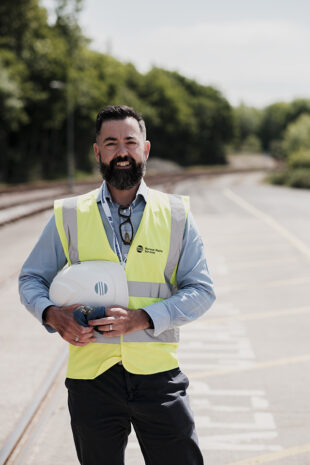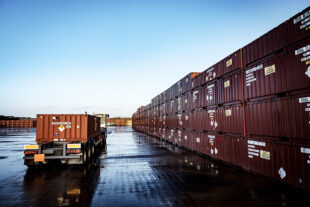 Over the last six decades, Mike Pigott and his team, and their predecessors, have been successfully managing the disposal of low-level radioactive waste at the Low Level Waste Repository in Cumbria.
Over the last six decades, Mike Pigott and his team, and their predecessors, have been successfully managing the disposal of low-level radioactive waste at the Low Level Waste Repository in Cumbria.
With 65 years of experience in safe radioactive waste disposal, they play a pivotal part in NWS’ commitment to make nuclear waste permanently safe, sooner.
Mike Pigott, Director of Sites and Operations, has a pivotal role, leading, directing, and controlling all activities on the nuclear-licensed site. He oversees the site’s safety, environmental compliance, and the critical role of responsible stewardship, making sure the site meets legal obligations and its moral duty to the environment and the community.
Taking the lead
In my role, I wear many hats. I oversee low level waste operations, manage infrastructure and facilities, care for our assets, and drive repository development such as our capping operations commitment to dispose of our waste inventory under its final engineered cap.
My commitment to running a safe and efficient site extends far beyond the present. This site will continue long after I’m gone, long after my successor’s gone, and long after their successor’s gone. That’s where responsible stewardship comes in. I’m a temporary custodian with a legal and moral obligation to leave the site even better than I found it. Then my successor can take what I leave behind and improve it again. We want to create a chain of continuous improvement on our journey to dispose of the nation’s low level radioactive waste in the safest way possible.
Our focus continues beyond our day-to-day operation. Through continuous improvement and innovation, we work to ensure the site performs at its best now, and that is prepared for future challenges. With decades of experience behind us, we continue to build the confidence of our key stakeholders to demonstrate our ability as an organisation to safely manage and dispose of radioactive waste, and therefore reinforce the foundation on which we will be trusted as an organisation to develop and operate a Geological Disposal Facility (GDF).
But I couldn’t do it alone. I have a team of dedicated professionals in security, environmental compliance, technical and engineering, safety and more, who make it possible to do what I need to do. Together we build and maintain relationships with the local community, monitor impact on native wildlife and oversee a critical part of our infrastructure, a railway siding!
A day in the life
It’s hard to say what a typical day is like for someone working at the repository. It’s incredibly varied and involves a deep sense of responsibility. Typically, we’ll receive containers of waste through our railway. These are checked to make sure we’ve received what we were expecting. The container is then filled with a type of liquid cement called grout. We’ll then dispose of the container in our vaults. We of course work closely with our Waste Management Services team, so that where appropriate, we’re also applying the waste hierarchy. We are treating or using alternate disposal routes where appropriate for waste that doesn’t require the protection of an engineered vault, which also helps to protect our capacity for waste disposal on-site.
From managing waste containers, to conditioning waste and disposal, maintaining security on site, and ensuring the smooth operation of critical facilities on site, every member of the team plays a pivotal and varied role. Take Chris Arthur for example, our dedicated on-site Ecologist. He makes sure our operations are in harmony with the environment and wildlife as we continue to develop and operate the site. He’ll give us the foresight to offset any developments we make.
Connecting with our community
Our site borders the village of Drigg. That means engaging with the community is a crucial part of our mission. We try to give back to the community as much as we can, especially as some of our work may affect them. For example, if a big operation is starting up, I’ll need to speak to locals about the use of their roads to deliver equipment and possible noise issues. We’ll leaflet drop, speak at parish council meetings and give them a place to check in with us. We have a huge spectrum of accountability. That includes safety, but also mitigating the risk of dust and noise pollution.
We know many of our neighbours by name and we like to find new ways to engage with their community projects. Like supporting the Drigg History Club by providing a plaque that memorialised lives lost during WWII at an explosives factory on the original site, which at the time employed most of the village. We also recently supported a local community group to identify an old shipwreck on the nearby coast by helping them get hold of some geographic equipment. It's about building trust and ensuring that our work benefits everyone.
The future of our site
By the successful diversion of waste to be reused, recycled and treated, we’ve protected the disposal capacity for low level radioactive waste for the UK. We’ve built additional capacity too. However, we’re now focussed on capping operations and permanently securing our existing vaults and historic trenches.
But what does capping mean? We’ve currently got half a million cubic meters of low level waste permanently disposed of at the site. Whilst it is extremely safe, putting a cap over the top of it would make it permanently safe, sooner. A long-term programme is now underway to permanently close the existing vaults and adjacent trenches – and initial work on the ground has now begun. The project is a significant scope of work both in terms of scale and complexity. The first stage of the Capping Operations project is now progressing, and will take five years.
The foundation of nuclear waste management
The Repository is pivotal in the UK's nuclear infrastructure and to Nuclear Waste Services. Our 65-year track record demonstrates that we have the track record to safely manage nuclear waste, and to develop and operate a Geological Disposal Facility (GDF). By effectively managing the waste inventory, we've ensured the protection of people and the environment from the hazard that exists with the waste. We know what we are doing.
Our commitment to safety and responsibility is critical in ensuring that we can be trusted with the challenges of the future, today. We are the foundation upon which the future of nuclear waste management rests, and our track record and future legacy speaks volumes.
Thanks to my team and the whole of NWS, we can continue our work to ensure the UK’s nuclear waste is permanently and safely disposed of.

Recent Comments